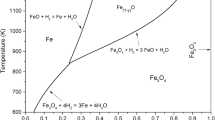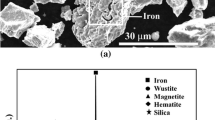Abstract
The relative importance of transport phenomena, as opposed to chemical phenomena, in controlling the kinetics of hematite reduction has been debated for a long time. Recent measurements of gaseous diffusion coefficients in the porous iron and intermediate oxide layers produced by the reduction have shown that gaseous diffusion plays an increasingly important role, especially towards the end of the reaction. Convective mass transfer, however, is still assumed to play a negligible role, principally because of the way in which the reduction rate of hematite particles varies with the gas flow rate, and with the particle diameter. The established theories of convective mass transfer are used in this paper to show that the observed variations would occur whatever contribution convective mass transfer was making to controlling the reduction rate. The observed variations, therefore, give no indication as to the relative importance of convective mass transfer. This paper then, makes a quantitative comparison between the mass transfer rates necessary to sustain the reaction rates observed in recent hematite reduction experiments and the rates predicted by the established theories of mass transfer. This comparison shows that convective mass transfer can play a major role in controlling the reduction rate, although the relative magnitude of its contribution varies with particle size, and with reduction temperature.
Similar content being viewed by others
References
N. A. Warner:Trans. TMS-AIME, 1964, vol. 230, pp. 163–76.
R. G. Olsson and W. M. McKewan:Trans. TMS-AIME, 1966, vol. 236, pp. 1518–22.
R. G. Olsson and W. M. McKewan:Met. Trans., 1970, vol. 1, 1507–12.
B. B. L. Seith and H. V. Ross:Trans. TMS-AIME, 1965, vol. 233, pp. 180–85.
E. T. Turkdogan and J. V. Vinters:Met. Trans., 1971, vol. 2, pp. 3175–88.
J. O. Edstrom:JISI, 1953, vol. 175, pp. 289–304.
E. T. Turkdogan and J. V. Vinters:Met. Trans., 1972, vol. 3, pp. 1561–74.
P. N. Rowe, K. T. Claxton, and J. B. Lewis:Trans. Inst. Chem. Eng., 1965. vol. 43, pp. T14–31.
G. H. Geiger and D. R. Poirer:Transport Phenomena in Metallurgy, Addison-Wesley Publishing Co., Reading, Mass, 1973.
E. N. Fuller, P. D. Schettler and J. C. Giddings:Indust. & Eng. Chem., 1966, vol. 58, pp. 19-00
L. V. Bogdandy and H. J. Engell:The Reduction of Iron Ores. Springer-Verlag, Berlin, 1971.
A. W. D. Hills:Heterogeneous Kinetics at Elevated Temperatures, G. R. Belton and W. L. Worrell, eds., pp. 449–501, Plenum Press, 1970.
R. H. Spitzer, F. S. Manning, and W. O. Philbrook:TMS AIME, 1966, vol. 236, p. 726.
Author information
Authors and Affiliations
Rights and permissions
About this article
Cite this article
Hills, A.W.D. The importance of convective mass transfer in the reduction of hematite. Metall Trans B 9, 121–128 (1978). https://doi.org/10.1007/BF02822679
Received:
Issue Date:
DOI: https://doi.org/10.1007/BF02822679




